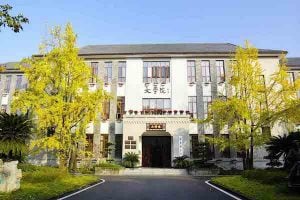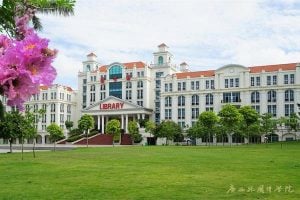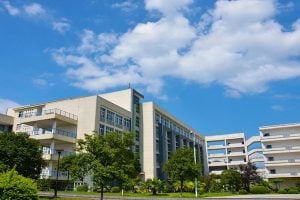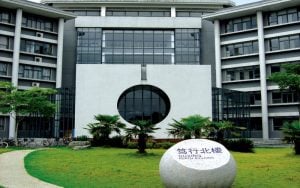Shanghai Ocean University
 |
 |
 |
 |
Introduction to Shanghai Ocean University
Shanghai Ocean University (上海海洋大学, website) is a multi-disciplinary applied research university. The Shanghai Municipal People’s Government, the State Oceanic Administration, and the Ministry of Agriculture and Rural Affairs jointly build universities. In September 2017, he was selected as the country’s “world-class discipline construction university”. Shanghai Ocean University was formerly known as Jiangsu Provincial Aquatic School, founded in 1912. After going through the names of the Fisheries School of the Agricultural College of the National Central University, the Shanghai Wusong Fisheries College, and the Shanghai Fisheries College. In 1952 it was upgraded to Shanghai Fisheries College, the first undergraduate aquatic university in China. In 1972, it moved to Xiamen Jimei to the south and changed its name to Xiamen Fisheries College. In 1979, he moved back to Shanghai to restore Shanghai Fisheries College and retain Xiamen Fisheries College. In 1985 it was renamed Shanghai Fisheries University. In 2008 it was renamed Shanghai Ocean University.
Shanghai Ocean University has 14 colleges (departments), with nearly 12,000 full-time undergraduates and more than 3,000 full-time graduate students. In 2018, there were 616 international students studying in 68 countries and regions. There are more than 1,200 faculty members, including more than 800 teaching and scientific researchers, more than 490 senior professional and technical positions, and more than 400 doctoral supervisors and master supervisors on campus. It has 25 national talents, 157 provincial and ministerial talents, 2 members of the 7th Discipline Evaluation Group of the State Council, 57 persons enjoying special allowances from the State Council, and 10 post scientists in the modern agricultural industry technology system of the Ministry of Agriculture.
The university has 42 undergraduate majors (including directions), including 5 national specialty majors, and the food science and engineering majors have obtained IFT food international certification. There are 3 national excellent courses, 45 excellent courses in Shanghai, demonstration courses, etc., 1 national teaching team, 4 municipal teaching teams, 2 national experimental teaching demonstration centers, 1 overseas practice base, nearly 200 There are 2 domestic teaching practice bases, 5 teaching and research bases, and 2 national-level virtual simulation experimental teaching projects. Since 2013, they have won 6 first-class awards and 12 second-class awards in Shanghai’s teaching achievements. The school is the first batch of pilot schools for ideological and political education and teaching reform in Shanghai, and the first batch of demonstration universities for deepening innovation and entrepreneurship education reform. The school is the first batch of “Easy Class” pilot units in the country, and has won the National University Campus Culture Construction Excellent Achievement Special Award, Shanghai Education Reform Experiment Award First Prize and many other honors. Website “, won the national” Top Ten Easy Class Student Workstation “,” Best Ideological and Political Innovation Award “,” Best Civilized Network Community Award “and other honors. Since 2005, the University Student Mental Health Research and Education Center has been named as “Shanghai University Mental Health Education and Counseling Demonstration Center” by the Shanghai Education Commission for three consecutive rounds. The campus culture of the school is colorful, and artists such as Qin Yi, conductor Cao Ding and composer Chen Gang are hired as part-time professors. There are more than 90 cultural and scientific student organizations such as university art troupes, and regular university student science, technology, culture and art festival And postgraduate Haichuan Academic and Cultural Festival; won several gold and silver awards in national college student art exhibitions. Consecutive years by the Central Propaganda Department, the Ministry of Education, the League Central Committee, the National Federation of Students as “advanced unit of summer social practice for college students.” There are cultural history education venues such as the school history hall (including the three history halls, the campus culture exhibition hall for college students), museums (aquatic biotechnology hall, whale hall, ocean fishery hall, “rainbow fish” deep-sea science popularization base).
Shanghai Ocean University currently has 4 first-level discipline doctoral degree authorization points, 11 first-level discipline master degree authorization points, 2 second-level discipline master degree authorization points, 7 professional degree master’s degree authorization points, and 2 postdoctoral research stations . It has one national first-class construction discipline, one national key discipline, three peak and plateau disciplines in Shanghai universities, three first-class disciplines in Shanghai universities, and nine provincial and ministerial key disciplines. The two disciplines of plant and animal science and agricultural science entered the top 1% of the global ESI international disciplines, and aquatic sciences received an A + rating in the fourth round of national discipline evaluation. It has one national engineering technology research center, one national engineering laboratory, one international joint research center of the Ministry of Science and Technology, one national university science park, and more than 30 provincial and ministerial key laboratories and platforms. There are a number of university-level scientific research platforms including the International Ocean Research Center, the China-Australia International Cooperative Research Center, the Ocean Fisheries International Compliance Research Center, and the Marine Science Research Institute. It owns China’s first ocean-going fishery resource survey ship “Yanghang” and China’s only CNAS and CMA qualified ship ballast water laboratory. It is the guiding unit of Shanghai Fisheries Society, Shanghai Food Society and Shanghai Fisheries Economic Research Association. Since 2011, he has made a number of breakthrough research achievements in the natural sciences, humanities and social sciences. He has won one national science and technology progress award and 32 provincial and ministerial awards as the first complete unit. The school gives full play to the advantages of disciplines and scientific research, and has served the society with remarkable results. Since 2011, he has assisted farmers in Miaoli County, Taiwan to cultivate hairy crabs, and created a model of cross-strait agricultural cooperation. He has established a “Fishermanship Team of Fishery Science and Technology Professors” to provide targeted poverty alleviation services in Tibet, Xinjiang, Shaanxi, and Guizhou. Since the 1990s, the compliance team has undertaken the tasks of fulfilling the regional fisheries management conventions on behalf of the country, and has made important contributions to safeguarding the rights and interests of China’s offshore fisheries.
Shanghai Ocean University currently has two campuses, the Huchenghuan Campus in Pudong New District, Shanghai, and the Gonggong Road Campus in Yangpu District. There are also 386 mu of Binhai Base and 56.7 mu of Xiangshan Science and Education Base. Among them, the main campus of the Huchenghuan campus covers an area of about 1,600 mu, with a planned construction area of 586,000 square meters. It has a modern campus network, and has a China Ocean Fishery Data Center and a Marine Science Supercomputing Center. There are more than 1.48 million paper books, 1.08 million electronic books, and 61 databases. The collection resources highlight the school’s marine, aquatic and food characteristics. Hosted the first aquaculture and fisheries English journal in mainland China; Aquaculture Journal and Journal of Shanghai Ocean University were sponsored by Chinese core journals, Chinese science core journals and CSCD source journals “Journal of Fisheries” won the titles of “China Top 100 Newspapers”, “Chinese Excellent Journals” and “Hundred Outstanding Chinese Academic Journals”.
Shanghai Ocean University has close exchanges and cooperation with universities and international organizations in the United States, Japan, South Korea, Australia and other countries (regions). It has signed cooperation agreements with 116 universities and research institutions in 29 countries and regions. The Fisheries Society and the International Aquatic Resources Management Center have established long-term friendly and cooperative relations. More than 770 students were sent through study tours, exchange students, etc .; the “Asian Campus” of the “Marine Science and Technology Joint Education Plan Based on ‘China, Japan, and South Korea Education Integration'” with Ocean University of Tokyo, Ocean University of Korea, and Estre, Spain The short-term, dual-degree study programs such as the credit recognition Erasmus project between Madura University and Portugal provide a platform for teachers and students to further expand their international perspectives, cultivate their international communication capabilities, and enhance their international competitiveness.
Shanghai Ocean University will be built into the three main disciplines of ocean, aquatic products, and food by 2020. The advantages of agriculture, science, engineering, economics, management, culture, and law will be coordinated. “Society” has a high degree of interpretation and is an internationally influential high-level characteristic university. In 2030, it will become a high-level characteristic university with important international influence. By 2050, the school will be built into a world-class characteristic university.
Teaching Program
![]() ISAC University Teaching Program
ISAC University Teaching Program
Related Universities







